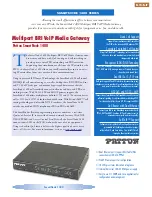
QX5
QXFXO4/QXISDN4/QXE1T1/QXFXS24; (SW Version 6.0.x)
38
QXFXO4/QXISDN4/QXE1T1/QXFXS24 Manual II: Administrator’s Guide
CAS Signaling Wizard – Page 3
allows to set the destination for
incoming calls to be routed to and to enable
Cut Through
and
Automat Ringing Down
services for signaling different from R2 (all
types).
Route Incoming Call to
drop down appears when
Both incoming
and outgoing calls
or
Incoming calls only
is selected from the
Allowed Call Type
list and allows selecting the destination where
incoming calls should be routed. The list contains all extensions of the
QX, Attendant and Routing agent. The routing agent gives two kinds of
call routing possibilities in user mode and one in network mode.
Choosing the
Routing
selection (available in User mode only) will
request the caller to pass the authentication (if enabled) and will
invite the caller to dial the destination number to connect the user
within the QX Network.
Choosing the
Routing with inbound
destination number
selection will automatically use the initially
dialed number to connect the destination without any additional
dialing.
When
DID service
is enabled (in User mode only), incoming calls can
be only routed to the Routing agent with simple
Routing
and
Routing
with inbound destination number
call routing possibilities.
Fig.II- 44: CAS Signaling Wizard – Page 3
Attention:
When QX acts in the Network mode with the Attendant as a destination to route the incoming calls, digit forwarding should be disabled on the
PBX side. Otherwise, incoming digits may be mistaken as special calling codes on the QX’s Attendant.
Cut Through
checkbox is available when signaling selected from the
Signaling Type
drop down list on the
CAS Signaling Wizard – Page 2
is different
from R2 (all types) and is used to reconnect the call (terminated by some reason, e.g. user error, network problems, etc.) by going on-hook and off-hook
again even if the call partner is off-hook and not involved in the call.
Automat Ringing Down
checkbox is available when signaling selected from the
Signaling Type
drop down list on the
CAS Signaling Wizard – Page 2
is
different from R2 (all types) and allows an E1/T1 device connected to the QX to establish a hot-line call (automatic call without any digits dialed).
Pass Through Pound Sign (#)
checkbox is only available when signaling selected from the
Signaling Type
drop down list on the
CAS Signaling Wizard
– Page 2
is different from E&M FGD or R2 (except for R2-DTMF). When this checkbox is selected, the pound sign (#) detected in the dialed number will be
passed through and will be considered as a part of the dialed number. When this checkbox is not selected, the detected pound sign (#) will be considered
as a call acceleration digit.
CAS Signaling Wizard – Page 4
appears only in E1 User mode when
signaling selected from
Signaling Type
drop down list on the
CAS
Signaling Wizard – Page 2
is R2 (all types) and is used to configure
country settings. Page consists of the following components:
Country
drop down list is used to set the location where QX is
located to support the correct functionality of R2 signaling. For
countries absent in this list, use
ITU
selection.
Use Default Country Settings
checkbox restores default advanced
settings for the selected country. When this checkbox is not selected,
next page will provide a possibility to manually configure advanced
country settings.
Fig.II- 45: CAS Signaling Wizard – Page 4
CAS Signaling Wizard – Page 5
appears only in E1 User mode when signaling selected from
Signaling Type
drop down list on the
CAS Signaling Wizard
– Page 2
is R2 (all types) and when
Use Default Country Settings
checkbox is not selected on the previous page. This page is used to configure advanced
country settings. Page consists of the following components:
ANI Category
drop down list appears only when R2 signaling selected from
Signaling Type
drop down list on the
CAS Signaling Wizard - Page 2
is
different from
R2 DTMF
is used to select the calling party priority depending on the call originator’s location specifics.
ANI Request Transmit
and
ANI Request Receive
drop down lists allow you to select the Caller ID request R2 tones for transmit and receive.
Seize Acknowledge Timeout
text field is used to define a timeout (in a range from 2 to 2000 milliseconds) between incoming seize signal and the
corresponding feedback.
Answer Guard
Timeout
text field is used to define a wait timeout (in a range from 0 to 1000 milliseconds) Group-B Answer Signal and Line Answer.
Release Guard
Timeout
text field is used to define an idle timeout (in a range from 0 to 120000 milliseconds) between the disconnect signal receipt and
call disconnection.
















































